Beautiful and comfortable attic: device and calculation
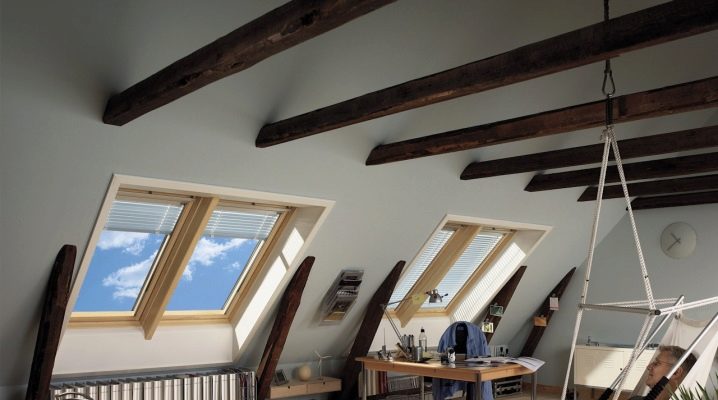
The free space under the roof of the house can be converted into a residential attic. This is not only a rational option to turn the attic into a functional area, but also a great way to increase the usable area.
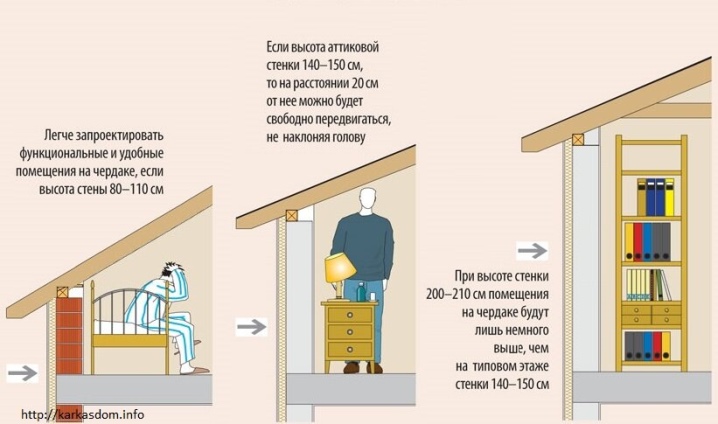
Turning an attic into a room is not difficult today. Fortunately, there are advanced technologies and modern materials for this. Often, all work is carried out independently, taking into account the nuances of such a room.
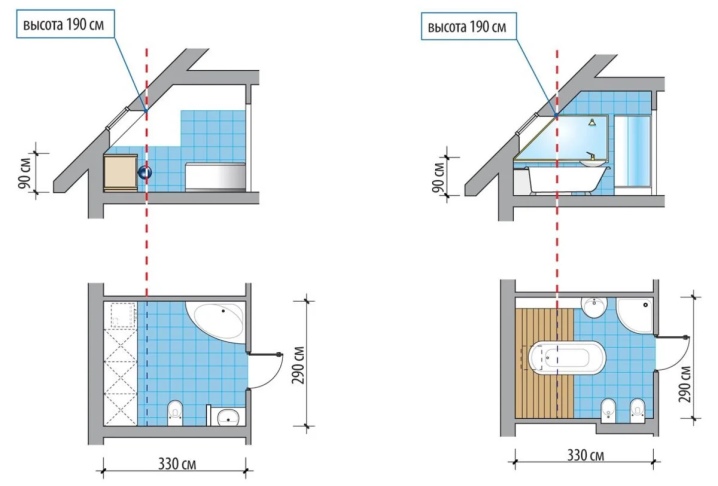
Arranging a free zone under a roof is useful not only from an aesthetic point of view, but also from a functional one. When carrying out work on the arrangement of the upper part of the house, the attic roof is additionally insulated.
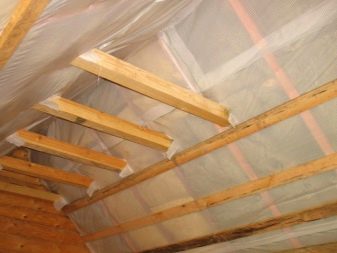

Peculiarities
The popularity of houses with an attic is due to the peculiarity of the architecture of the building. The attic got its name from the founder - French architect Francois Mansaroux in the 17th century. Since then, it has become convenient to use the last floors of buildings, although initially they were reserved for household needs, it was not a living or warm room.
Today it is quite possible here, for example, to equip an additional bathroom. But more often the room is modified for an additional bedroom, living room or playroom for children. The attic will never be a living room in the traditional sense, due to the broken roof and technical nuances. However, this does not prevent many from planning the construction of houses precisely taking into account additional meters, just in case. Like any building, an attic room in a private house has its own characteristics, advantages and disadvantages.

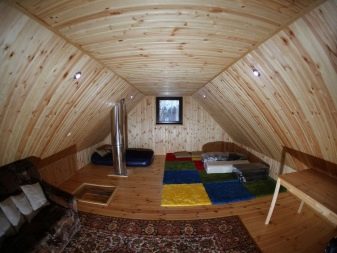
It is worth mentioning the following main advantages of a functional room in a private house:
- no need to build additional structures;
- the building is able to increase the area of the house;
- no need to solve problems with sealing building;
- you can beat the design of the external appearance of the structure;
- even a two-tier design is reliable;
- heat loss is reduced (especially in winter it is noticeable);
- in the process of arranging the attic, as a rule, major repairs are not required.
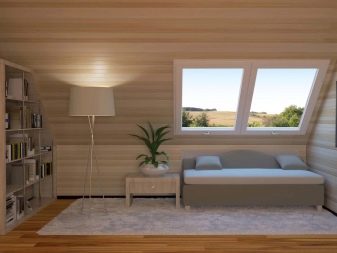
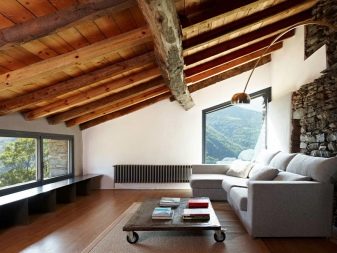
When assessing the quality of the building as a whole, it will be useful to recall the shortcomings of the attic:
- sometimes this is not an opportunity to increase the space, but a clear "loss" of useful meters (mainly in old houses);
- problems can appear with sloped ceilings and walls;
- hydro and thermal insulation of the house leaves much to be desired (what to say about the attic);
- old skylights sometimes cause a lot of problems.
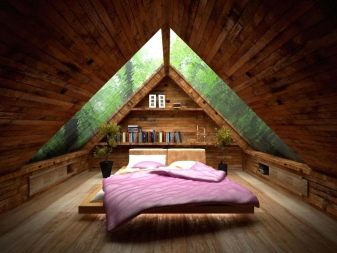

The peculiarities of the attic floor often consist in the fact that this room itself (more often in modern houses) extends almost along the entire perimeter of the house. In this regard, it is often necessary to modify or supplement the front part of the house (parapets, niches, ledges, decorative elements) in accordance with the technical features of the roof. In individual construction, the possibility of completing or altering the attic roof is provided.
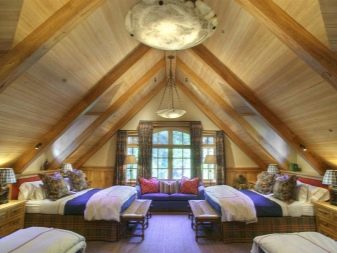
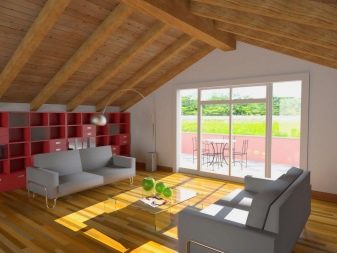
Types of roof structures
Individual construction is characterized by the use of various options for the roofing system.
Particular attention is paid to the construction of a mansard roof, which differs in the main types of structures:
- single or gable (broken, gable);
- hip and half hip.

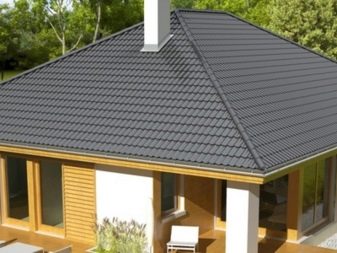
The characteristic features for each type determine the possibility of arranging the attic.
Today, in addition to traditional ones, more modern forms are used:
- single-pitched mansard roof with an inclined area (mounted on load-bearing walls);
- a rigid gable roof attic with a slope on opposite sides;
- sloping roof (installation of a gable roof option);
- a hip or half-hip roof having four slopes (the end slopes of the hip roof differ in shape in the form of beveled triangles (the gable area is protected at the half-hip roof);
- pyramidal (also called hipped) types of roofs, which are not widespread, differ in polygonal shapes.
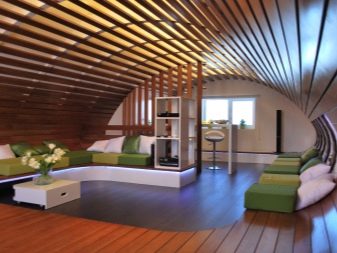
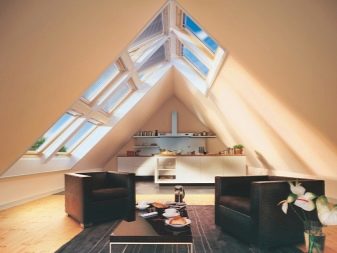
The shape of the roof is not the only distinguishing feature of the modern mansard roof. What matters is the height of the building and the nature of the coating (corrugated board, metal, you can make plastic tiles).
Separately, it is worth highlighting the universal distinctive features of the attic roof:
- it is not only the roof, but also the walls of the house;
- the maximum building height is not more than 2.5 m;
- the possibility of installing reinforced-plastic windows with tempered glass;
- multilayer structure;
- the cost of a mansard roof is, in the end, more than the usual one.
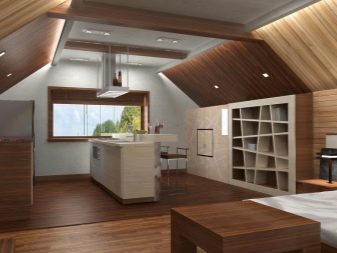
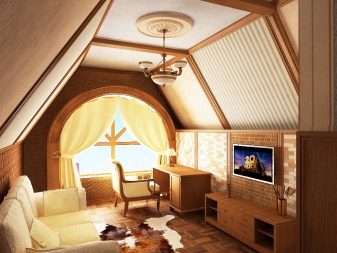
Even when designing a house, you can choose the most suitable roof shape, if necessary, lengthen the rafter legs (layering from the walls about 50-55 cm), calculate the loads and allocate space for windows.
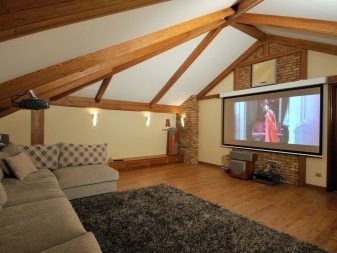

Types and sizes
The highest point of the height of the under-roof space must be at least 2.5 m in order to consider this room as an attic. Otherwise, it is already an attic. According to SNiP, you can set the minimum value from ceiling to floor.
Differences in the types of attic roofs are determined by the following values:
- semi-attic - with a vertical wall height of less than 0.8 m;
- attic - with a wall height of 0.8 to 1.5 m;
- floor - with a wall height of more than 1.5 m.

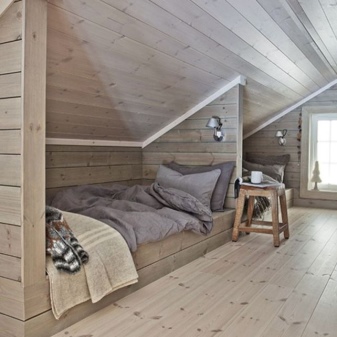
Living rooms in such attics have vertical walls, while the average wall height here can be 2.5 m according to the standards.
The minimum height of the ceiling (floor) of the inclined section is also spelled out in SNiP:
- tilt angle 30 degrees - 1.2 m;
- tilt angle of 45 degrees - 0.8 m;
- an angle of inclination of 60 degrees or more is not standardized.
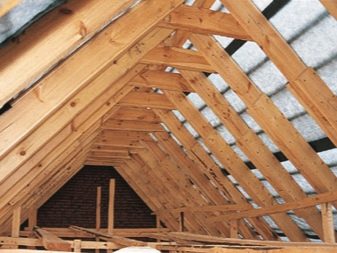

The width of the structure is another major factor in determining the type of attic. The minimum norms in width are at least 80 cm.For a residential attic, this indicator (width) increases to 2 m, especially if the width of the house itself is at least 4.8 m.As for the building area, this parameter can be set using a special formula. Calculations are carried out in accordance with building codes and regulations. The area of an ordinary attic cannot be less than 16 sq. m. The attic construction project covers all structural elements - roof slopes, retaining walls, gables, rafters. The type and size of the attic space is fully taken into account.
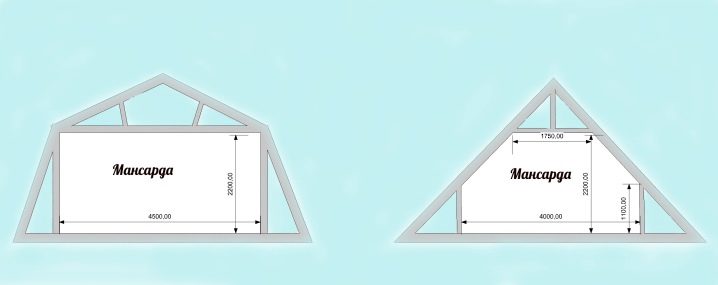
In general, the work on the arrangement of the attic is as follows:
- the roof is checked;
- lathing is performed (made of wooden boards);
- fastening of insulating materials is carried out;
- the top of the rafter structure is strengthened;
- stiffeners are checked (if necessary, replaced) - roof rafters;
- beams are placed along the perimeter of the outer walls, they are connected to the rafter structure;
- diagonal bevels (ties) are made to give strength to the attic roof;
- the supporting supports are strengthened.
- A waterproofing layer, insulation is being laid.
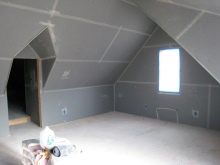
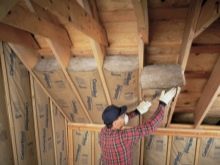

Calculating the useful area
When arranging the under-roof space, it is important to correctly calculate the area of the attic room. The size, size, height of the attic, features of the angle of inclination have a close relationship in the calculations. Any redevelopment is carried out in accordance with the norms of SNiP. So, according to this provision, the minimum height of a dwelling under the roof is 2.5 m.The slope of the roof affects the calculation of the room height. Thanks to the calculations during the design, it is possible to reflect the real parameters of the upper floor of the house to obtain a useful area.
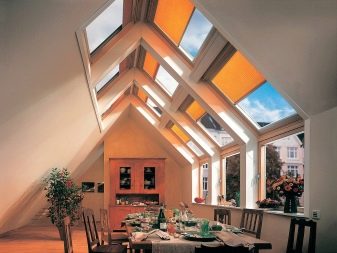
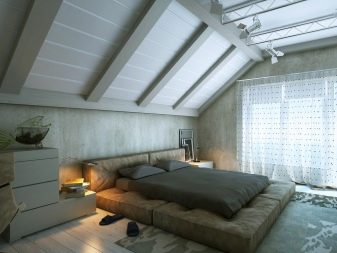
When calculating the area of the attic, you can do it yourself, but the initial data will depend on the following parameters:
- the level of the slope is 30 degrees (in the narrowest part of the slope, the height is 1.5 m);
- the level of the slope is 45 degrees (in the narrowest part of the slope, the height is 1.1 m);
- the level of the slope is 60 degrees and higher (in the narrowest part of the slope, the height is 0.5 m).
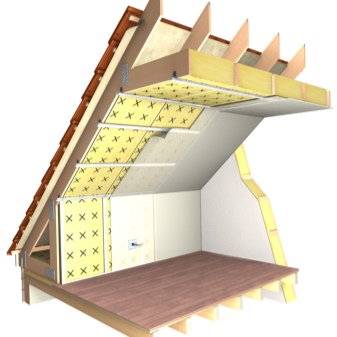

To calculate the area of the structure, the smallest height is takena and multiplied by 0.7 (reduction factor). Then, for the minimum level of the walls of the attic with a slope of 30 degrees, an indicator of 1.2 m is obtained; from 45 to 60 degrees - 0.8 m; over 60 degrees - do not limit. It is important to remember that a successful attic project with a modern roof requires accurate and accurate calculations, for this you can use specially developed computer programs (a work scheme will appear before your eyes).
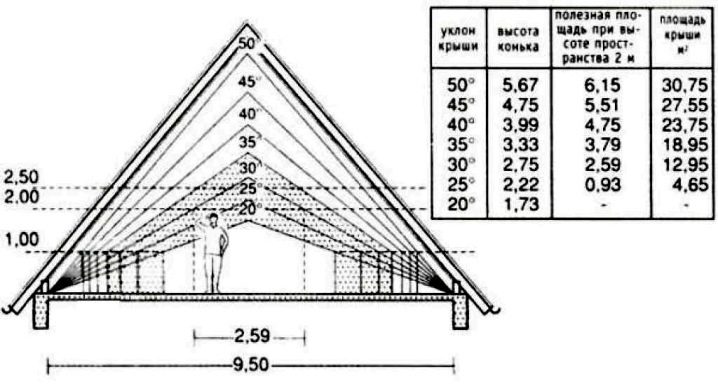
Design and materials
When choosing materials for the construction of an attic, timber is traditionally chosen; aerated concrete is also actively used. But there are other options for building and finishing materials for construction, the main thing is that it is a frame technology. The choice is made based on the type of structure and its size, the configuration of the roof and the slope of the walls are taken into account. For the frame of the attic, wooden rafters are best suited, moreover, it is important that they are perfect - without cracks and knots, especially without traces of decay.
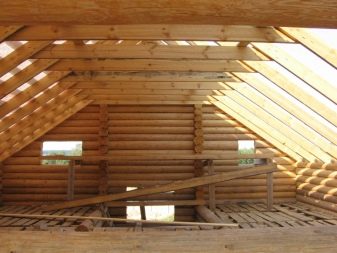
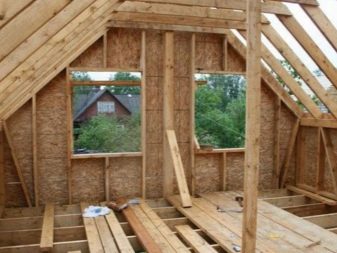
As for the choice of aerated concrete, it is a fairly cheap and easy-to-install material. In addition, it is strong and durable. Aerated concrete blocks can be additionally processed with a special tool. However, due to lime, which is part of the material, aerated concrete cannot be classified as environmentally friendly materials. Instead, you can use corrugated board, foam blocks or vulture panels. The advantages of the foam block include a sufficient level of noise and heat insulation.
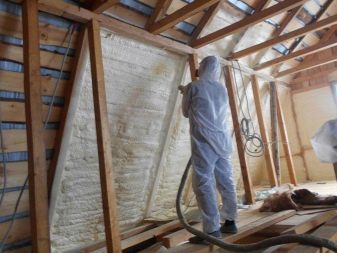

When arranging the under-roof space, competent design and drawings are of great importance. Modern mansard roofs are deservedly popular not only in suburban construction. More and more different options for small country houses with an equipped attic appear in our open spaces. It's all about the rationality and efficiency of such a room. Of interest are ready-made schemes for roofing structures, which imply a classic attic, although the rework of space, even in an old house, is not always major. Most of the schemes are not very complicated, so the entire attic or balcony can be designed and done by hand. There are separate schemes for ready-made structures, where beams and floors do not even change.
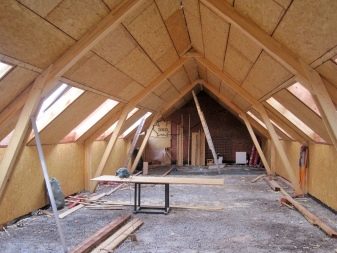
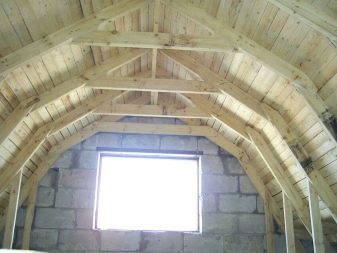
Designing should be done at the initial stage of construction or renovation. The attic floor is included in the project of the house. And the choice of the roofing type largely depends on how successful the building will be as a whole. The finished attic space can also be skillfully converted and equipped, turning it into a full-fledged functional room. Thanks to modern technologies and materials, it is not a problem today to design an attic floor in a finished house. The project can be selected by the type of attic.
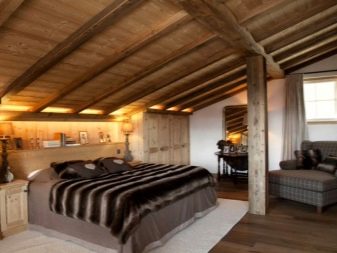
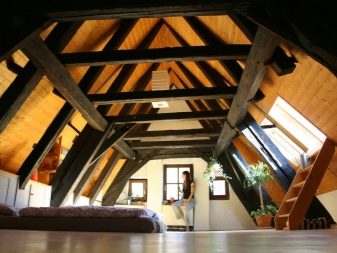
Forms
The room under the roof has a special role to play so that it can be used comfortably.
To this end, a number of requirements are imposed on the attic under the attic:
- the shape of the attic should be as convenient as possible;
- you need to pay attention to insulation;
- room lighting is also important.
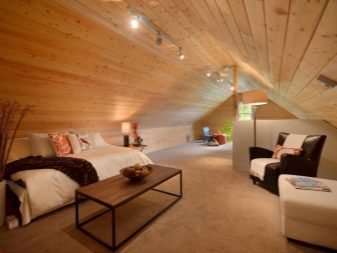

A competent layout will help to embody many useful ideas. The geometric shape of the attic has become a classic of the genre.Such a roof can be triangular or broken, with symmetrical or asymmetrical sides relative to the walls of the building. The floor itself can be located either on one side or across the entire width, even slightly going beyond the boundaries of the outer walls. Some of these projects involve the installation of additional support structures, for example, in the form of columns or walls.

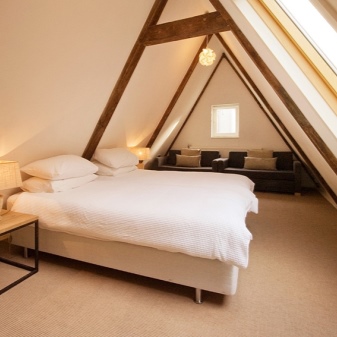
In general, roof structures can be designed as follows:
- as a separate multi-level floor;
- a solid floor with a two-level development;
- a two-level floor with a mezzanine floor base.
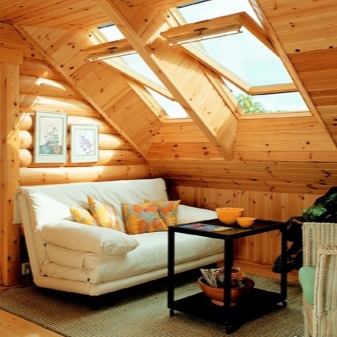
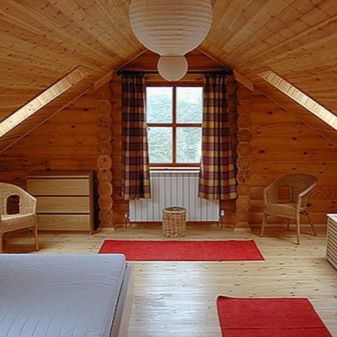
The load-bearing walls of roof structures usually consist of two parts:
- a vertical wall (the wall material for the structure can be used the same as for the construction of the lower floors);
- an inclined wall (the rafter system serves as its frame, and the roof serves as an outer sheathing).


The ratio in the project of all these elements to each other depends on the design as a whole. The shape of the mansard roof gives the whole house a special look. Residential attic spaces can vary in the shape of the roof.
Basically, it is customary to distinguish the following types:
- single-pitched roof (without sidewalls, with a single roofing room);
- a gable roof (a complicated structure that allows you to design a comfortable attic floor, taking into account the attic windows);
- sloping gable roof with a characteristic silhouette (slopes can be curved inward or curved outward).


A competent project allows you to "free up" the required usable area. It can be increased by installing a vertical, attic wall. It is worth considering that the useful area of a hipped roof is less than that of a gable. This is due to the large number of bevels, which do not allow freely designing the under-roof space. It is optimal to use a typical attic project.
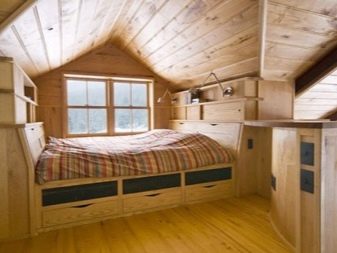
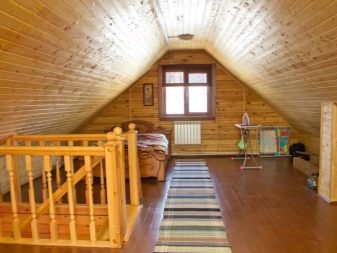
Since the height of the attic floor is important, it affects the usable floor space. In addition, the type of room under the roof is distinguished by height. For the big picture, it does not hurt to study the project of a typical attic structure in section.
Consider what it is.
- If the height of the vertical wall of the roofing room is more than 1.5 m, then this is already a full-fledged floor. In the center of the structure, you can move freely without bending over. With a wall height of the attic of more than 2 m, we can talk about a functional room, which, in terms of comfort, will resemble a typical room.
- If the attic has a single or gable roof with a height of attic walls of about 0.8 m (maximum up to 1.5 m), then such a structure is distinguished by increased functionality.
- The presence of walls with a height of less than 0.8 m (or if there are no vertical walls) may indicate an insufficiently functional room.
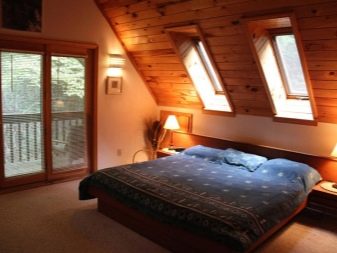
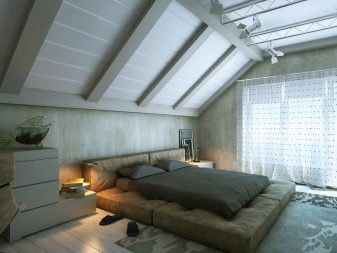
There are several ways to turn the attic into a functional room, more convenient and rational. The general tone is also set by the interior of the under-roof room. Sometimes, for its arrangement, extraordinary solutions may be required, but it is better to follow well-known and proven rules in the work. So, the quality characteristics of the attic largely depend on the purpose of the room. For example, a small, narrow attic can be conveniently turned into an additional bedroom. The high attic allows you to equip an entire guest floor under the roof. It is also important what kind of furniture will be in the room and, accordingly, you can build in a wardrobe or put a rack.
It is important to comply with two general requirements:
- for a large room, the height of the walls to the floor from the ceiling is not less than 2.2 m;
- the height of the attic walls from the bed level is about 1.4 m.
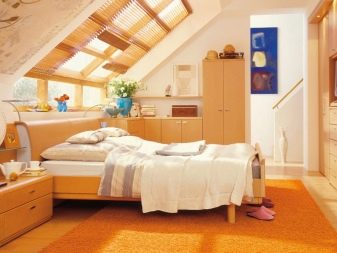
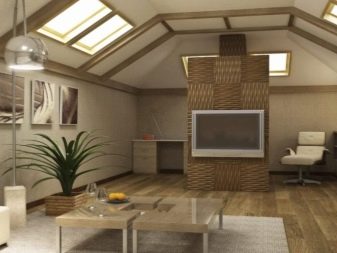
A competent ceiling arrangement will improve the proportions of the room under the roof to the required ones (in accordance with the norms).

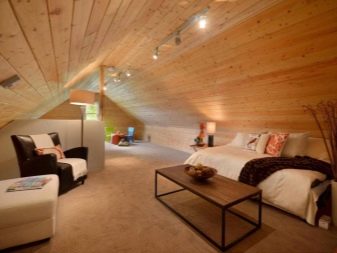
Device
The construction of an attic roof with your own hands implies a solid foundation and a reliable floor, the presence of reinforcing supports to relieve the load due to the attic floor (the attic needs to be additionally strengthened). Sometimes it is necessary to additionally strengthen the foundation of the house or redo a separate foundation. One cannot do without professional skills.

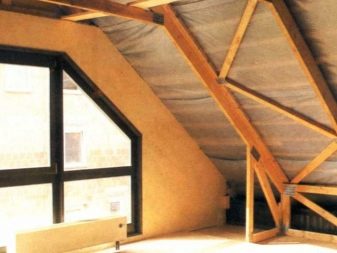
Stingrays
Even at the initial stage of the attic device, it is necessary to resolve all issues related to the design features of the building, taking into account all the partitions.The house may have ramps that affect the overall design. And the under-roof space itself can differ in a variety of forms. The interior decoration of the attic will depend on the features of the roof structure. If the roof of the house is designed in a special way, then you will have to remove the old rafters and materials, replacing them with new ones, taking into account the specifics of the project (additional load, angle of inclination and other structural features of the building are taken into account).
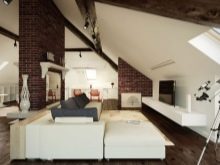
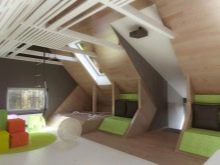
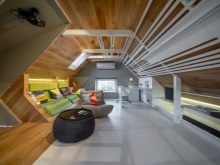
Rafter system
The entire rafter structure must be sized and designed for the type of attic floor. The best option for a typical house is the manufacture of an attic floor with a broken gable roof. Such a roof has a large load on the walls, however, the combined area of the attic is most often arranged in this way. At the same time, it is important to comply with the requirement for the presence of additional bearing supports (installation of inclined rafters designed for vertical and horizontal loads). When installing the rafter system, the Mauerlat is installed, after which the rafter legs are assembled and installed. The installation of the rafters is carried out, starting with two opposite legs, they are pulled over each other (the installation accuracy must be adjusted). This is how the frame of the rafter system is installed, after which the lathing is performed, which depends on the roofing material.
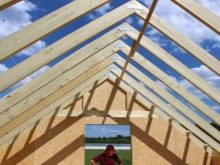

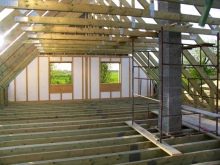
Roof
When arranging the upper floor, it is important to take into account the complexity of the attic roof. It differs from a typical roof by the fact that it bears the functional load of the residential and under-roof space. The ceiling of the house is a mansard roof with the necessary noise and heat insulation layers, with the finishing of the premises. It should be as warm, comfortable, spacious and light as possible. Additional lathing of the roof structure will improve the quality of the attic floor's thermal insulation, although mineral wool can serve as the main insulation for this purpose.
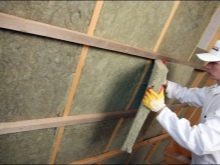
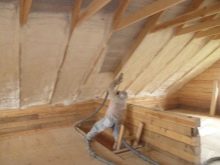

The quality finish of the roof-ceiling depends on the purpose of using the attic. So, for example, lining, fiberboard, plywood sheets are traditionally used for giving. The decoration of living quarters is carried out with more substantial and expensive materials. Roofing material for exterior decoration creates comfort for the interior of the attic. In this case, slate, bitumen-based materials and modern tiles are traditionally used. It is better not to use metal sheets, they do not retain heat and create additional noise during rain and wind. It is also better to refuse roofing material, since in summer it heats up a lot, emitting a specific smell.
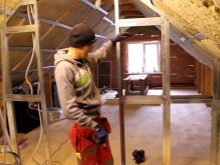

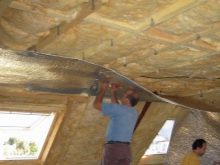
Window
The correct frame for the roof structure includes the arrangement of the windows. They are installed between the rafters. For the reliability of the window attachment points (bottom and top of the structure), horizontal jumpers are placed from the timber.
Installation of roof windows is carried out in stages:
- constructing an opening for a window;
- mount the frame with the dismantled glass unit;
- lay insulation and a layer of waterproofing;
- fastening the gutter of the window structure;
- install details;
- the dismantled glass unit is returned to its place;
- carry out interior decoration.
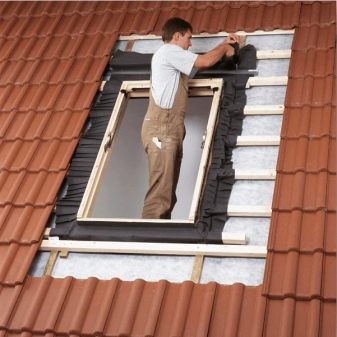
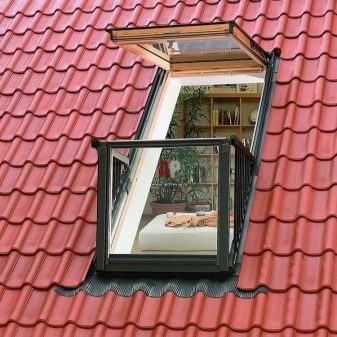
There is not always a constructive opportunity to build or expand the usable area of the house by adding a full-fledged upper floor or side structure. To increase space in small houses, it is best to use the attic. It does not take up much space, but it allows you to "unload" the house a little, saving on construction costs.
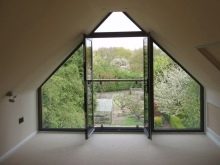
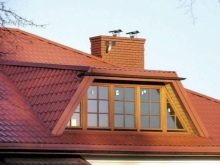
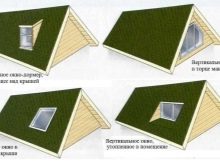
In order to build an attic or make it out of an attic space, you need to stock up on materials:
- rafters are placed from wooden beams (with a section of 50x180 cm);
- the crate is made of a wooden board;
- the sheathing of the end walls is made of wall panels;
- we carry out fastening of roofing elements on self-tapping screws, nails, metal profiles and metal corners;
- during construction, heat-insulating, vapor-insulating and waterproofing materials are necessarily used;
- at the finishing stage, roofing material is used;
- at the end, the interior decoration of the room is made from modern facing materials, the main heating is installed.

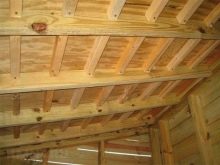

Before starting work, it is important to make sure that the floors that are located between the first floor and the attic are sufficiently strengthened. It is necessary to calculate the loads. After making sure of the reliability of the fasteners, you can proceed to the arrangement of the rafter system. In the course of work, the quality of the connections of each element of the system is monitored. For a sloped roof project, support beams with end walls are installed first. After that, work begins on the collection of the frame structure of the rafter system.
Individual elements of the rafter system are fastened with a groove-ledge connection and with metal plates for greater reliability. All wooden elements can be used after special treatment for additional protection. Treatment with fire retardants is also required to reduce the flammability of wood structures. After assembling the rafter system, they proceed to processing the bevels of the walls and internal partitions.
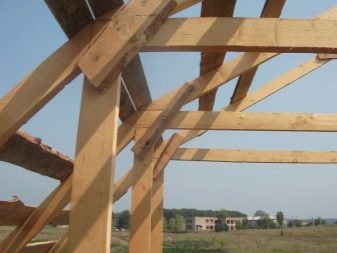
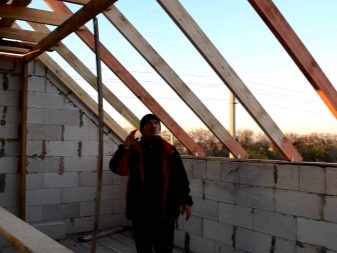
An obligatory stage during the construction of the attic is the ventilation of the attic floor. It was enough for the attic to provide ventilation of the room. The attic building must meet the requirements of the living space. Ventilation problems can lead to heat loss, moisture condensation, and rot. All these external factors can lead to subsequent destruction. Simple ventilation is ineffective here; forced ventilation of the system and insulation is required.
Next, the arrangement of several layers of the attic roof is carried out: the very top is the roofing material, underneath is the waterproofing material, the lathing, the thermal and vapor barrier material, and the ceiling finish. It is important to emphasize that the sequence of layering must not be changed. Installation of insulation is carried out on the rafter system. There is a gap between the insulation and the roof for natural ventilation. In some cases, insulation (mineral wool and other fire-resistant insulator) is placed on the crate.
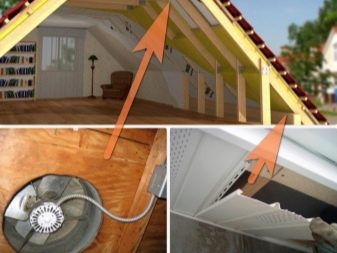
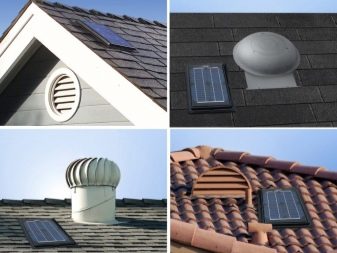
The thermal insulation layer in thickness is about 25-30 cm. For reliable fixation of this layer, an additional frame perpendicular to the rafters can be used. A vapor barrier in the form of a breathable membrane and a waterproofing material are attached at some distance from the insulation. It is worth considering that not only the roof should be insulated, but also the walls of the attic room to ensure greater comfort. The result is a "pie" that ensures the reliability and strength of the structure. The finishing of the roof-ceiling is done in the usual way - with plywood sheets, ceiling tiles, drywall, clapboard.
The decorative finish of the attic depends on the overall design of the room. Usually, the walls and ceiling are covered with wallpaper in the style of the decoration of the whole house. Walls can also be painted or plastered.

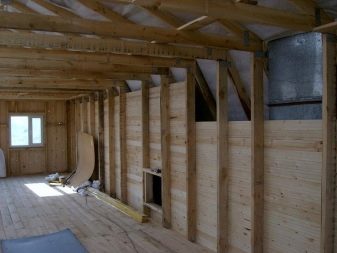
Warming and soundproofing
The main sound insulation in the attic room falls on the floors. Sound absorption is necessary to ensure comfort in the upper part of the floor, and so that excess noise does not spread to adjacent rooms.
For this purpose, old proven methods and new technologies are used:
- polyethylene foam with foil is laid on the logs (on one side);
- sand 5 cm thick is poured between the beams.
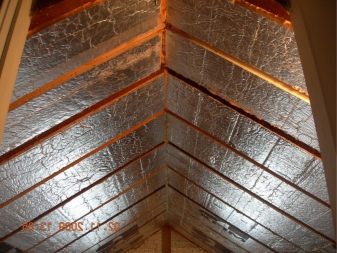
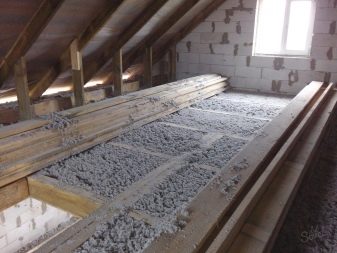
Competently executed sound insulation dampens shock noises from above, be it steps, falling objects. For sound absorption, mineral wool, foam or felt, as well as basalt slabs are often used. Vapor barrier and thermal insulation are also provided.
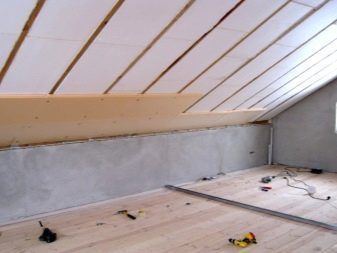
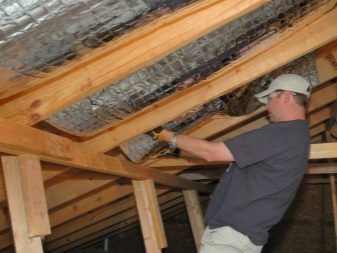
Due to the constant contact of the attic roof with atmospheric loads, summer overheating or winter cooling of the roof, it is necessary to carry out work on additional insulation of the attic. To do this, even at the stage of construction, a special protective layer of insulation and films against moisture is laid under the slate or other flooring. The main front of the attic waterproofing is carried out from the inside after the end of the main stage of construction.
It is important to leave a small space between the roofing layer and the insulation for natural ventilation. Today, additional external insulation of the attic is carried out with modern means so as not to reduce the usable area inside the attic building. The low weight of the insulation does not allow the structure to sag or deform. There are special heaters on sale - materials for spraying. They create an even, durable surface that prevents moisture build-up.

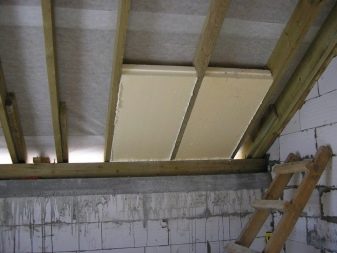
Finishing
Original and practical solutions for facing a wooden or brick attic space give free rein to imagination. The design of the attic is largely determined by the general design solution, but sometimes the most daring ideas are used. The cladding of the attic floor is primarily associated with the features of the finished structure. In this regard, the interior decoration of the attic has a number of features.

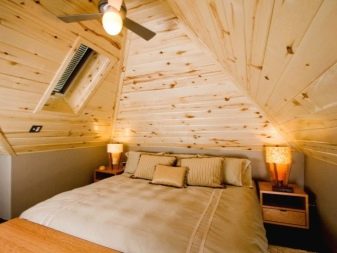
It is necessary to pay attention to several points.
- The interior appearance of the attic is influenced by the presence of dormer windows. They are located on the roof slopes. An ordinary window is placed on a flat wall, the room acquires more light.
- You can come up with unusual designs for the attic walls, for example, in colorful shades that contrast with the color of the ceiling or floor.
- The bevels of the attic roof can be designed in a design way, emphasizing all the unusual design of the attic room.
- The special atmosphere of the attic space is set by non-standard furniture (for example, irregularly shaped). A low, uneven cabinet fits perfectly in a narrow and low part of the attic.
- The attic, which is large in area, can be divided into functional zones.

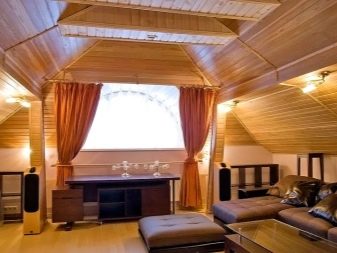
There are a lot of options for zoning an attic space today to find the best option for your home. All internal work can be done both independently and with the help of professionals.
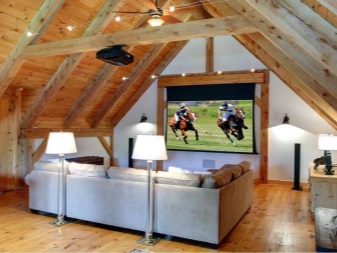
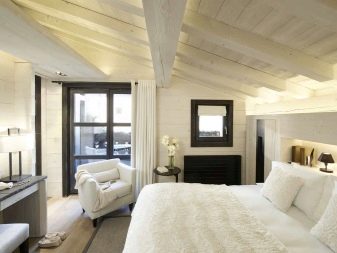
See below for more details.













Best description I've seen. Almost like a book! Awesome! Thanks!
The comment was sent successfully.